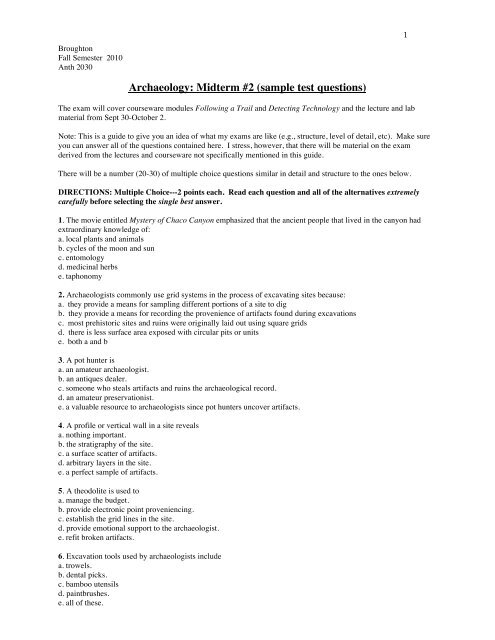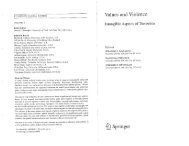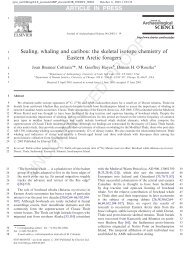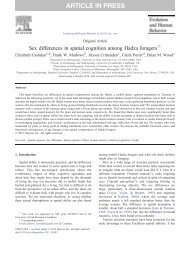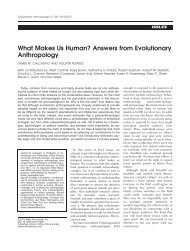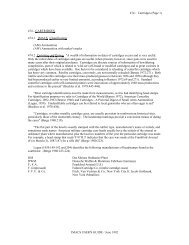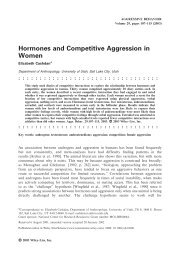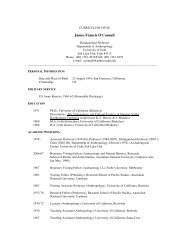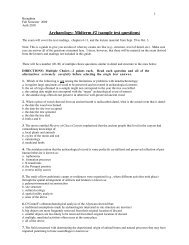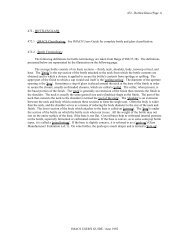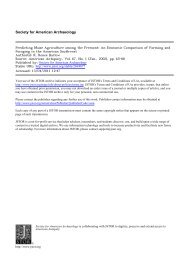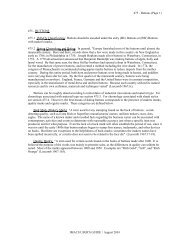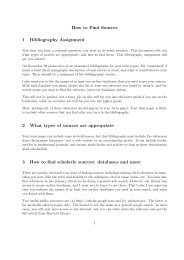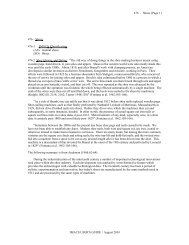Archaeology: Midterm #2 (sample test questions)
Archaeology: Midterm #2 (sample test questions)
Archaeology: Midterm #2 (sample test questions)
- No tags were found...
Create successful ePaper yourself
Turn your PDF publications into a flip-book with our unique Google optimized e-Paper software.
BroughtonFall Semester 2010Anth 20301<strong>Archaeology</strong>: <strong>Midterm</strong> <strong>#2</strong> (<strong>sample</strong> <strong>test</strong> <strong>questions</strong>)The exam will cover courseware modules Following a Trail and Detecting Technology and the lecture and labmaterial from Sept 30-October 2.Note: This is a guide to give you an idea of what my exams are like (e.g., structure, level of detail, etc). Make sureyou can answer all of the <strong>questions</strong> contained here. I stress, however, that there will be material on the examderived from the lectures and courseware not specifically mentioned in this guide.There will be a number (20-30) of multiple choice <strong>questions</strong> similar in detail and structure to the ones below.DIRECTIONS: Multiple Choice---2 points each. Read each question and all of the alternatives extremelycarefully before selecting the single best answer.1. The movie entitled Mystery of Chaco Canyon emphasized that the ancient people that lived in the canyon hadextraordinary knowledge of:a. local plants and animalsb. cycles of the moon and sunc. entomologyd. medicinal herbse. taphonomy2. Archaeologists commonly use grid systems in the process of excavating sites because:a. they provide a means for sampling different portions of a site to digb. they provide a means for recording the provenience of artifacts found during excavationsc. most prehistoric sites and ruins were originally laid out using square gridsd. there is less surface area exposed with circular pits or unitse. both a and b3. A pot hunter isa. an amateur archaeologist.b. an antiques dealer.c. someone who steals artifacts and ruins the archaeological record.d. an amateur preservationist.e. a valuable resource to archaeologists since pot hunters uncover artifacts.4. A profile or vertical wall in a site revealsa. nothing important.b. the stratigraphy of the site.c. a surface scatter of artifacts.d. arbitrary layers in the site.e. a perfect <strong>sample</strong> of artifacts.5. A theodolite is used toa. manage the budget.b. provide electronic point proveniencing.c. establish the grid lines in the site.d. provide emotional support to the archaeologist.e. refit broken artifacts.6. Excavation tools used by archaeologists includea. trowels.b. dental picks.c. bamboo utensilsd. paintbrushes.e. all of these.
27. Preliminary lab work that is usually conducted at the site involves washing, bagging and _____ artifacts.a. writing publishable material aboutb. potassium argon datingc. radiocarbon datingd. labelinge. stratifying8. Artifacts that are too small to be individually identified during excavation are removed from the matrix bya. sonar imaging.b. trained dogs.c. infrared cameras.d. wet or dry screening.e. radiocarbon dating techniques.9. Surveys that are designed to gather a representative <strong>sample</strong> of information on artifact and site distributions in aregion are known as:a. non-systematic surveysb. gumshoe surveysc. systematic surveysd. superimposed surveyse. seriation surveys10. Surveys that rely on intuition to get a qualitative sense for the archaeology in a region are known as:a. non-systematic or “gumshoe” surveysb. probabalistic surveysc. systematic surveysd. stratified random surveyse. none of the above11. Who was involved in one of first applications of remote sensing in American archaeology?a. Charles Lindberghb. W.W. Taylorc. Lewis Binfordd. Charles Darwine. Max Uhle12. The most important characteristic of processual archaeology is:a. a strict adherence to the scientific methodb. an extreme skepticism of sciencec. the goal to align archaeology with the humanitiesd. the goal to align archaeology with historye. both a and c13. The two main classes of archaeological data recovery are:a. survey and excavationb. flotation and mappingc. informant <strong>test</strong>imony and experimentationd. ethnography and expert witnessese. none of the above14. The post-processual paradigm in archaeology:a. does not embrace a strict scientific approachb. posits that environmental and economic factors are the strongest determinants of human behaviorc. embraces the notion of the Great Chain of Beingd. was pioneered by Marie Wormingtone. both b and d15. Flintknapping refers toa. manufacture of ground stone tools.
Stratified random samplingPinyon-Juniper ZoneLower Sagebrush ZoneProcessual archaeologyPost-processual archaeologyNAGPRASystematic surveyPlant or crop marksSpirit Cave ManOldowan toolsAcheuleanSherdsProfileTheodoliteBulb of percussionBulbar ScarArrisChoncoidal fractureMonroeville cemeteryArchaeological surveyRemote sensingArbitrary levelsMousterianNeolithicChristian ThomsenFlintknappingGordon WilleyBaulk4There will be one or two essay <strong>questions</strong> similar in detail and structure to the ones below. Study tip: Carefullypreparing answers to these <strong>questions</strong> will not only help you prepare for this section of the exam, but will help for themultiple-choice and definition sections as well.DIRECTIONS--Short Essay Questions: Write a clear and concise answer to the following <strong>questions</strong>.1. Discuss in detail D.H. Thomas’ survey strategy in the Reese River Valley. Be sure to indicate the goals of theproject, the methods he used to achieve them, and the primary conclusions.2. Survey can be done systematically or based on ones intuition. Provide examples of a systematic and a nonsystematicarchaeological survey. Describe the differences between the two methods?3. How has the discovery and analysis of Kennewick Man and other pre-8000 year old human skeletons in NorthAmerica changed the traditional view of human colonization of the New World?4. Make a chart showing the temporal sequence of Great Basin Projectile Point types. Be sure to include the typenames and the dates of their occurrence.5. Describe three primary goals of prehistoric archaeology and how analyses of stone tool technology can be used toaddress them.


